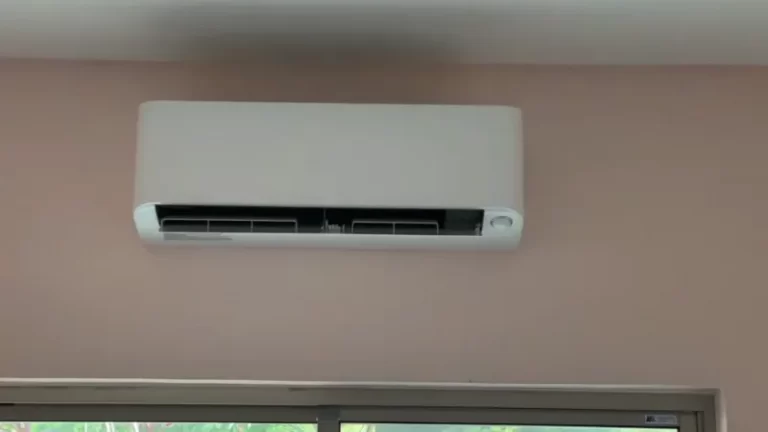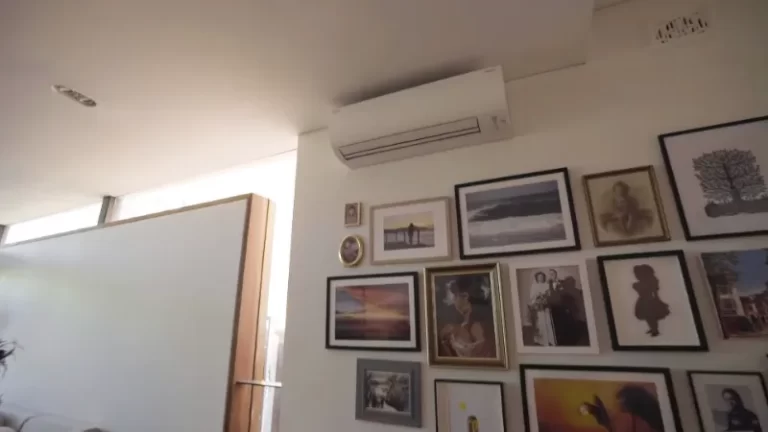GE Refrigerator Temperature Control Problems and Solutions
GE refrigerators are known for their quality, durability, and advanced technology. They are designed to provide optimal storage conditions for food and keep them fresh for longer periods. However, like any other appliance, GE refrigerators can experience temperature control problems that can affect their performance and efficiency.
Proper temperature control is crucial in refrigerators as it helps to prevent the growth of harmful bacteria and maintain the freshness of food. In this blog, we will discuss 5 to 10 common GE refrigerator temperature control problems and the solutions to fix them.
By understanding these issues and their solutions, you can keep your refrigerator running smoothly and extend its lifespan.
You'll Learn About
GE Refrigerator Temperature Control Problems
GE refrigerators are known for their innovative features and efficiency. These refrigerators come in different models and sizes to cater to different needs. The temperature control system is one of the most important features in a refrigerator.
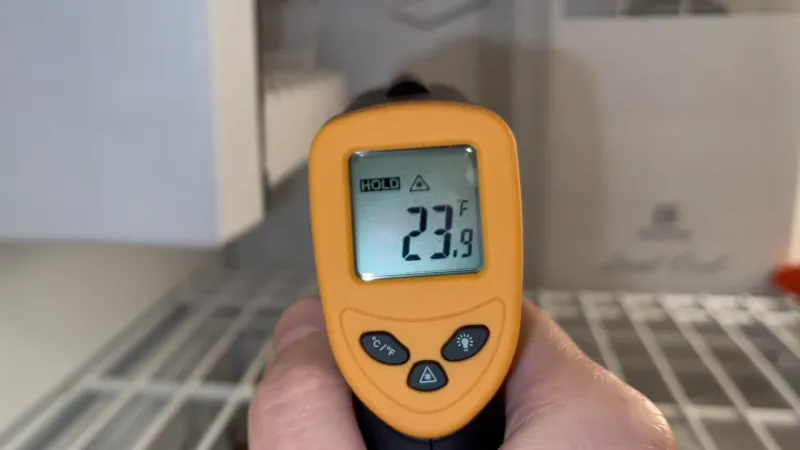
It is responsible for maintaining the desired temperature inside the refrigerator and keeping the food fresh for a longer time. However, over time, GE refrigerators may show problems with the temperature control system.
In this blog, we’ll discuss 5 to 10 common GE refrigerator temperature control problems and their solutions.
GE Side by Side Refrigerator Defrost Problems and Solutions
Problem 1: Refrigerator Dispenser Not Working
This is a common issue faced by GE refrigerator owners. The refrigerator dispenser is used to dispense water and ice. When it doesn’t work, it can be a major inconvenience.
The possible causes of this problem are clogged dispenser nozzles, a defective water inlet valve, and a faulty dispenser switch. To solve this problem, clean the dispenser nozzles, check the water inlet valve, and replace the dispenser switch if necessary.
Problem 2: Ice Maker Won’t Make Ice or is Too Slow
Another common issue with GE refrigerators is the ice maker. It may not make ice at all or make it too slowly. The possible causes of this problem are low water pressure, a clogged water filter, and a defective ice maker.
To solve this problem, check the water pressure, replace the water filter, and replace the ice maker if necessary.
Problem 3: Temperature Display Not Working:
A faulty temperature display can be a major inconvenience, as it makes it difficult to know the current temperature inside the refrigerator. The possible causes of this problem are a faulty control board, a faulty thermistor, and a loose connection. To solve this problem, replace the control board, the thermistor, or tighten the connections if necessary.
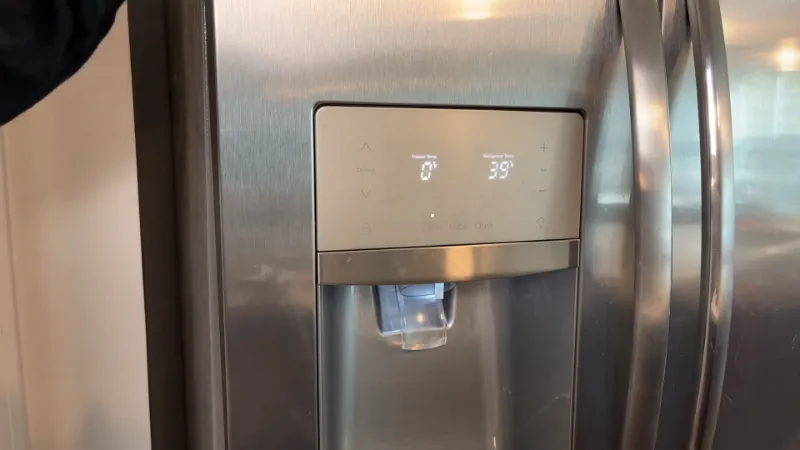
Problem 4: Refrigerator Not Cooling at All:
This is a serious problem, as it can cause food to spoil. The possible causes of this problem are a faulty compressor, a refrigerant leak, or a dirty condenser coil. To solve this problem, check the compressor, repair the refrigerant leak, and clean the condenser coil if necessary.
Problem 5: Freezer Not Freezing:
If the freezer isn’t freezing, it can cause food to spoil. The possible causes of this problem are a faulty thermostat, a faulty fan, or a refrigerant leak. To solve this problem, replace the thermostat, replace the fan, or repair the refrigerant leak if necessary.
Problem 6: Refrigerator Too Cold:
If the refrigerator is too cold, it can cause food to freeze. The possible causes of this problem are a faulty thermostat, a faulty control board, or a refrigerant leak. To solve this problem, replace the thermostat, replace the control board, or repair the refrigerant leak if necessary.
Can You Turn an Air Conditioner on Its Side? Risks and Precautions Explained
Problem 7: Refrigerator Not Defrosting:
If the refrigerator isn’t defrosting, it can cause frost buildup and affect the cooling efficiency. The possible causes of this problem are a faulty defrost thermostat, a faulty defrost heater, or a faulty defrost control board. To solve this problem, replace the defrost thermostat, replace the defrost heater, or replace the defrost control board if necessary.
Problem 8: Resetting the Temperature:
To reset the temperature on a GE refrigerator, go to the self-diagnostic mode by pressing any temperature button in the control panel.
Problem 1: Refrigerator Dispenser Not Working
The refrigerator dispenser is a convenient feature that provides access to cold water or ice without having to open the door. When the dispenser stops working, it can be a major inconvenience and affects the overall functionality of the refrigerator.

Possible Causes
There could be several reasons why your GE refrigerator dispenser is not working. Some common causes include a clogged water line, a defective dispenser control board, a broken water inlet valve, or a malfunctioning solenoid valve.
Solutions
To resolve the problem, you can try the following solutions:
- Clean the water line: If the water line is clogged, it can cause the dispenser to stop working. You can clean the water line by flushing it with warm water and a vinegar solution.
- Check the dispenser control board: If the control board is defective, it can cause the dispenser to stop working. You can check the control board by unplugging the refrigerator and checking for any signs of damage or corrosion.
- Replace the water inlet valve: If the water inlet valve is broken, it can cause the dispenser to stop working. You can replace the water inlet valve by turning off the water supply, removing the valve, and installing a new one.
- Check the solenoid valve: If the solenoid valve is malfunctioning, it can cause the dispenser to stop working. You can check the solenoid valve by unplugging the refrigerator and checking for any signs of damage or corrosion.
By following these steps, you can resolve the problem of the GE refrigerator dispenser not working and get it back to working properly. If the problem persists, it’s best to call a professional for assistance.
Problem 2: Ice Maker Won’t Make Ice or is Too Slow
The ice maker is an important part of a refrigerator as it provides the user with ice. However, sometimes the ice maker may stop working or work too slowly.
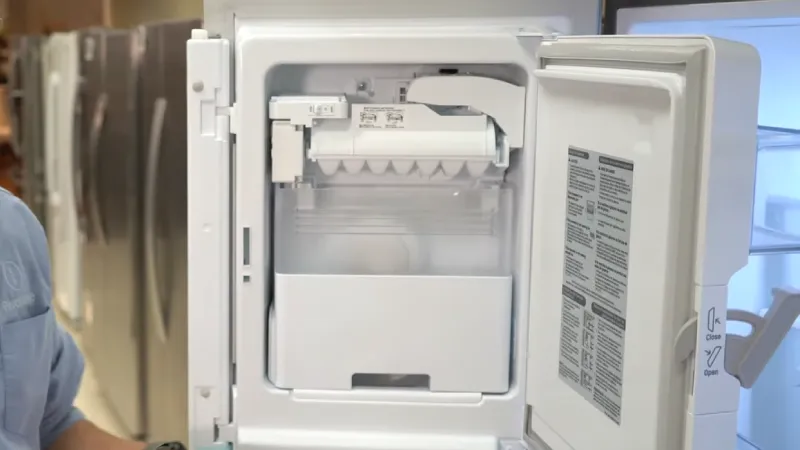
This can be due to various reasons, including clogged water lines, low water pressure, or a faulty ice maker assembly.
Possible Causes
- Clogged water line: Over time, the water line can get clogged with mineral deposits or debris, which reduces the flow of water to the ice maker.
- Low water pressure: If the water pressure in your home is low, it may not be enough to feed the ice maker, causing it to work slowly or not at all.
- Faulty ice maker assembly: The ice maker assembly may have worn out or become faulty over time, which can cause it to stop working or work slowly.
Solutions
- Clean the water line: Using a cleaner specifically designed for removing mineral deposits, clean the water line to restore proper water flow.
- Increase water pressure: If the water pressure in your home is low, you may need to install a booster pump to increase the pressure.
- Replace the ice maker assembly: If the ice maker assembly is faulty, it may need to be replaced to restore proper functioning of the ice maker.
if your GE refrigerator’s ice maker is not working or is too slow, it is important to address the issue promptly to ensure proper functioning of the refrigerator. By following the steps outlined above, you can diagnose and solve the problem, ensuring that you have access to ice whenever you need it.
Problem 3: Temperature Display Not Working
One of the most common issues with GE refrigerators is the temperature display not working. This issue can be frustrating as it makes it difficult to monitor the temperature of the refrigerator and keep the food fresh.
How Many Car Batteries to Run an Air Conditioner? A Detailed Guide
Possible Causes
There can be several reasons why the temperature display is not working, including:
- Control board malfunction
- Sensor failure
- Power outage
- Loose connections in the control panel
Solutions
- Check the control board and make sure it is properly connected and functioning.
- Replace the temperature sensor if it has failed.
- Check the connections in the control panel and make sure they are tight.
- If the power has gone out, wait for it to be restored and the display should work again.
If the temperature display still does not work after trying these solutions, it may be necessary to call a professional for further assistance. The issue may be a more complex problem such as a circuit board malfunction, and a professional will have the tools and knowledge to properly diagnose and repair the issue.
Problem 4: Refrigerator Not Cooling at All
One of the most common and frustrating problems with GE refrigerators is that the refrigeration compartment is not cooling at all. This can cause food to spoil and lead to a health hazard.
Possible Causes
There can be several causes for a GE refrigerator not cooling. Some of the most common include:
- Dirty or clogged condenser coils
- Faulty thermostat
- Malfunctioning compressor
- Leaking refrigerant
- Electrical problems, such as a blown fuse or tripped circuit breaker
Solutions
- Clean the condenser coils: Dust and debris can accumulate on the condenser coils over time, reducing the efficiency of the refrigerator. Clean the coils with a brush or vacuum to remove any dirt and debris.
- Check the thermostat: A faulty thermostat can prevent the refrigerator from cooling. Replace the thermostat if necessary.
- Test the compressor: If the compressor is not running, it will not be able to cool the refrigerator. Have a professional check the compressor for any issues.
- Address refrigerant leaks: A leak in the refrigerant system can prevent the refrigerator from cooling. Have a professional repair the leak.
- Check electrical connections: If the refrigerator is not cooling, check the electrical connections, including the fuse and circuit breaker. If necessary, replace the fuse or reset the circuit breaker.
If these solutions do not resolve the problem, it is best to call a professional for further assistance. Refrigeration repair can be dangerous and should only be performed by a qualified technician.
Problem 5: Freezer Not Freezing
When the freezer in your GE refrigerator is not freezing, it can be a frustrating experience. This can lead to food spoilage and the need to constantly replace food items.
The freezer is a crucial part of the refrigerator and needs to be functioning properly to maintain the temperature and keep food frozen.
Possible Causes
Problem 6: Refrigerator Too Cold
Problem 6: Refrigerator Too Cold A. Explanation of the problem When the temperature control system in your GE refrigerator is not functioning properly, it can result in the refrigerator is too cold.
This can lead to your food items getting frozen, making them inedible. This can also be a sign of an underlying issue with the refrigerator, which needs to be addressed promptly.
What is E5 Overcurrent Protection Error?
Possible Causes
- Thermostat malfunction: The thermostat is responsible for regulating the temperature in the refrigerator. If it is not functioning properly, it can result in the refrigerator becoming too cold.
- Air leaks: If there are air leaks in the seal around the door, it can cause the temperature to drop.
- Clogged condenser coils: Over time, the condenser coils can become clogged with dirt and dust, causing the refrigerator to become too cold.
Solutions
- Check the thermostat: Make sure the thermostat is set to the correct temperature and adjust it if necessary.
- Check the door seal: If you notice air leaks around the door, replace the door seal.
- Clean the condenser coils: Use a vacuum to clean the condenser coils to ensure proper air circulation.
- Call a professional: If the problem persists, call a professional to diagnose and repair the issue.
Problem 7: Refrigerator Not Defrosting
A common problem that GE refrigerator owners face is the unit not defrosting properly. Over time, the frost that builds up on the coils of the refrigerator can reduce its efficiency and affect its cooling performance.
Possible Causes
There could be several reasons for a GE refrigerator not defrosting properly, including:
- A faulty defrost thermostat
- A malfunctioning defrost timer
- A clogged defrost drain
- A malfunctioning defrost heating element
- A problem with the control board
Solutions
- Check the Defrost Thermostat: You can test the defrost thermostat by using a multimeter to see if it’s working properly. If it’s not, it’s best to replace it.
- Replace the Defrost Timer: If the defrost timer is not working properly, it may need to be replaced.
- Unclog the Defrost Drain: If the defrost drain is clogged, it can prevent the defrost water from draining properly. To fix this, locate the drain and clear any clogs.
- Replace the Defrost Heating Element: If the defrost heating element is not functioning properly, it may need to be replaced.
- Check the Control Board: If all other parts are functioning properly, the control board may be the problem. Have a professional check and repair it if necessary.
It’s important to address the problem of a GE refrigerator not defrosting as soon as possible to avoid further damage to the unit and ensure it operates efficiently. If you are not confident in performing these solutions, it is recommended to seek help from a professional.
Problem 8: Resetting the Temperature
The temperature on a GE Profile refrigerator can be reset through a self-diagnostic mode. This allows the user to adjust the temperature to their desired setting, ensuring that the food stored inside the refrigerator remains at the optimal temperature.
Step by Step Instructions
- Enter the self-diagnostic mode by pressing any temperature button on the control panel.
- Once the temperature display appears, press the number “5” in the settings.
- Hold down the four adjustment buttons for three seconds.
- The temperature display will reset, and you can set the desired temperature by using the adjustment buttons.
Tips and Tricks
- It is recommended to wait for a full day after resetting the temperature for the refrigerator to stabilize.
- If the lights continue to flash after 24 hours, unplug the refrigerator for 30 seconds and then plug it back in.
- Make sure to check the temperature regularly to ensure that it remains at the desired setting.
- If the problem persists, it may be necessary to call a professional technician to diagnose and repair the issue.
By resetting the temperature on your GE Profile refrigerator, you can ensure that your food remains at the optimal temperature, preventing spoilage and saving you money in the long run. If you are experiencing any other temperature control problems, it is best to consult the manufacturer’s manual or call a professional technician for further assistance.
Problem 9: Dirty Condenser Coils
Condenser coils are an essential component of a refrigeration system. They play a crucial role in removing heat from the refrigerant gas, which helps to cool the food stored inside the refrigerator. The condenser coils are typically located at the back or bottom of the refrigerator, and they are responsible for dissipating heat into the surrounding air.

How Dirty Condenser Coils Can Lead to Temperature Control Problems
Condenser coils tend to collect dust and debris over time, which can reduce their efficiency. When the coils become clogged with dirt, they are less effective at removing heat from the refrigerant gas.
This can cause the refrigeration system to work harder to maintain the desired temperature, leading to increased energy consumption and decreased performance. In extreme cases, a dirty condenser coil can cause the refrigeration system to fail altogether.
Samsung Refrigerator Problems and Solutions
Steps to Clean the Condenser Coils
To keep the condenser coils clean and functioning correctly, they should be cleaned regularly. Here’s how you can clean the condenser coils on your GE refrigerator:
- Unplug the refrigerator: Before you begin cleaning the coils, make sure to unplug the refrigerator to prevent any electrical hazards.
- Locate the coils: Look for the coils at the back or bottom of the refrigerator.
- Remove the dirt and debris: Use a vacuum cleaner with a brush attachment to remove any dirt, dust, or debris from the coils.
- Clean with a coil cleaning solution: After vacuuming the coils, use a coil cleaning solution to further clean the coils.
- Dry the coils: Use a clean cloth to wipe the coils dry and remove any remaining cleaning solution.
- Reassemble the refrigerator: Once the coils are clean and dry, reassemble the refrigerator and plug it back in.
By cleaning the condenser coils regularly, you can help ensure that your GE refrigerator is functioning correctly and maintaining the desired temperature.
Problem 10: Defective Evaporator/condenser Fan Motor
The evaporator/condenser fan motor is a crucial component of a refrigeration system. It is responsible for circulating air over the evaporator coils and the condenser coils. The evaporator fan motor blows air over the evaporator coils, which helps to remove heat and moisture from the air inside the refrigerator.
The condenser fan motor circulates air over the condenser coils, which helps to dissipate heat into the surrounding air.
How a Defective Fan Motor Can Cause Temperature Control Problems
A defective fan motor can cause a variety of problems, including reduced cooling performance and increased energy consumption. When the fan motor fails, it can cause the evaporator and condenser coils to become clogged with dirt and debris, which can reduce their efficiency. Additionally, a defective fan motor can cause the refrigeration system to work harder to maintain the desired temperature, leading to increased energy consumption and decreased performance.
Problem 11: Faulty Start Relay
The start relay is an electrical component that is responsible for turning on the compressor in a refrigeration system. The compressor is the heart of the refrigeration system and is responsible for compressing and circulating refrigerant to remove heat from the air inside the refrigerator. The start relay is usually located near the compressor and is connected to the compressor’s electrical circuit.
How a Faulty Start Relay Can Cause Temperature Control Problems
A faulty start relay can cause a variety of problems, including reduced cooling performance and increased energy consumption. When the start relay fails, it can prevent the compressor from turning on, which can result in the refrigeration system not being able to cool the air inside the refrigerator.
GE Refrigerators Problems and Solutions
This can cause the temperature inside the refrigerator to rise, leading to food spoilage and other problems. Additionally, a faulty start relay can cause the refrigeration system to work harder to maintain the desired temperature, leading to increased energy consumption and decreased performance.
Steps to Replace the Start Relay
If you suspect that your GE refrigerator’s start relay is faulty, it should be replaced as soon as possible. Here’s how you can replace the start relay:
- Unplug the refrigerator from the power source.
- Locate the start relay, which is usually located near the compressor.
- Disconnect the electrical connections from the start relay.
- Remove the faulty start relay and replace it with a new one.
- Connect the electrical connections to the new start relay.
- Plug the refrigerator back into the power source and turn it on.
- Monitor the temperature inside the refrigerator to make sure it’s cooling properly.
By following these steps, you can replace the faulty start relay and restore proper temperature control to your GE refrigerator.
Problem 12: Malfunctioning Compressor
The compressor is one of the most critical components in a refrigeration system, responsible for compressing the refrigerant and maintaining a constant flow of refrigerant to the evaporator. The compressor works by compressing the low-pressure refrigerant gas from the evaporator and converting it into high-pressure gas, which then moves to the condenser.
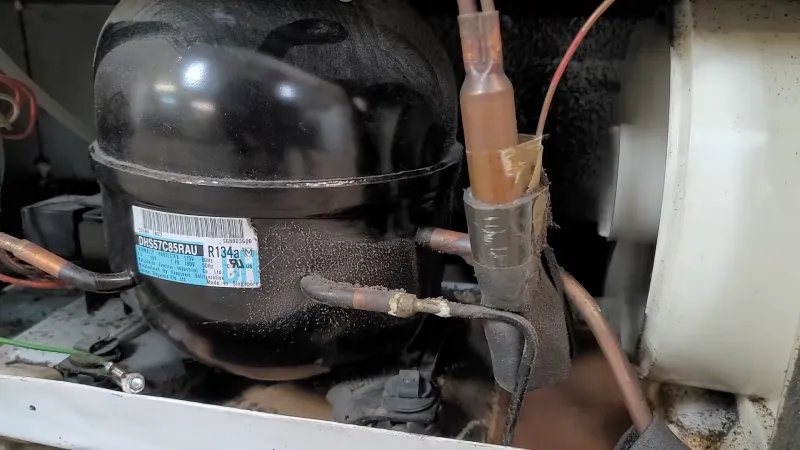
How a Malfunctioning Compressor Can Cause Temperature Control Problems
A malfunctioning compressor can cause temperature control problems in several ways. If the compressor is not functioning properly, it may not be able to maintain the correct pressure and flow rate of refrigerant, which can result in the refrigerant not being able to absorb heat effectively. This, in turn, can cause the temperature inside the refrigerator to fluctuate, leading to problems with temperature control.
Steps to Replace the Compressor
If you suspect that your GE refrigerator’s compressor is malfunctioning, it’s best to have a professional repair technician replace it. The steps involved in replacing the compressor include:
- Disconnect the power supply to the refrigerator and remove any food items.
- Locate the compressor and remove the electrical connections.
- Remove any mounting bolts or brackets holding the compressor in place.
- Remove the old compressor and replace it with a new one, making sure to connect all electrical connections correctly.
- Mount the new compressor using the bolts or brackets, and test it to ensure that it’s functioning correctly.
Note: Replacing the compressor is a complex and potentially dangerous task, and it’s recommended that you seek the assistance of a professional repair technician.
Problem 13: Overstuffing
Overstuffing in refrigerators refers to the practice of filling the fridge to capacity, leaving little to no room for air to circulate and maintain a consistent temperature. When a refrigerator is overstuffed, it becomes harder for the cooling system to distribute cool air evenly, leading to temperature control problems.
Amana Refrigerator Water Filter Problems and Solutions
How Overstuffing Can Lead to Temperature Control Problems
When the fridge is overstuffed, the air inside becomes stagnant and warm, making it difficult for the refrigeration system to keep the interior at the desired temperature. This can result in temperature fluctuations, which can cause food to spoil and potentially cause health problems. Additionally, overstuffing can put extra strain on the cooling system, potentially leading to system failures.
Steps to Prevent Overstuffing in Ge Refrigerators
To prevent overstuffing in your GE refrigerator, it’s important to regularly organize the contents and remove any expired or unused items. Make sure to leave enough room for air to circulate freely and keep the door from being overburdened.
It’s also recommended to allow hot food to cool down before storing it in the fridge, as this can help reduce the strain on the cooling system. Finally, it’s a good idea to regularly check the temperature inside the fridge to ensure it is at the recommended level and to periodically clean the interior and condenser coils to maintain the efficiency of the cooling system.
Problem 14: Incorrect Temperature Settings
The temperature settings of a GE refrigerator are used to regulate the internal temperature of the fridge and freezer compartments. This is an essential feature that helps keep food and drinks at their optimal storage temperature and prevent spoilage. The temperature setting can be adjusted using the control panel or the digital display on the front of the refrigerator.
How Incorrect Temperature Settings Can Cause Temperature Control Problems
When the temperature settings are incorrect, it can cause temperature control problems that affect the performance of the refrigerator. For example, if the temperature is set too low, the refrigerator may run continuously, trying to cool the interior to the desired temperature.
This can result in increased energy consumption, as well as a decrease in the lifespan of the compressor and other components. On the other hand, if the temperature is set too high, the refrigerator may not be able to cool the interior adequately, leading to food spoilage and a higher risk of foodborne illness.
Steps to Reset the Temperature Settings in Ge Refrigerators
Resetting the temperature settings in a GE refrigerator is a simple process that can be done by following these steps:
- Locate the control panel or digital display on the front of the refrigerator.
- Use the buttons or dial to adjust the temperature to the desired setting.
- Wait 24 hours for the temperature to stabilize before checking the setting again.
- If the temperature still doesn’t seem right, unplug the refrigerator for 30 seconds, then plug it back in and adjust the temperature again.
Hisense French Door Refrigerator Ice Maker Problems and Solutions
It’s important to note that the recommended temperature setting for a GE refrigerator is 37°F (2°C). This is the temperature that provides optimal storage conditions for food and drinks. If you’re unsure of the correct temperature setting for your specific model, consult the owner’s manual or contact GE customer service for assistance.
Editor’s Note
GE Profile refrigerators have various temperature control problems that can arise over time. Some common problems include the refrigerator dispenser not working, the ice maker won’t make ice or being slow, the temperature display not working, the refrigerator not cooling at all, the freezer not freezing, the refrigerator being too cold, and the refrigerator not defrosting. These problems can be associated with both the hardware and control system that establish and maintain the desired temperature.
To reset the temperature, GE Profile refrigerators have a self-diagnostic mode which can be accessed by clicking any temperature button in the control panel and following the instructions. The standard temperature for a GE fridge is 37°F (2°C) but this can vary depending on the model.
If the temperature control board fails, the user won’t be able to set the preferred temperature and the power cord needs to be disconnected from the wall mount. If the lights continue to flash after adjusting the temperature, reset the refrigerator by unplugging it for 30 seconds.
Conclusion
GE refrigerators are reliable appliances that provide efficient cooling and storage for your food and beverages. However, like all appliances, they may experience some temperature control issues that can affect their performance.
The 8 common problems outlined in this article, such as the refrigerator dispenser not working, ice maker issues, temperature display not working, and more, can be easily resolved with a few simple solutions.
It’s crucial to regularly maintain your GE refrigerator to avoid such problems and keep it running smoothly. In case the issues persist, it is always best to seek professional assistance to prevent further damage.
With the right care and attention, your GE refrigerator will continue to provide you with excellent cooling and storage solutions for many years to come.

